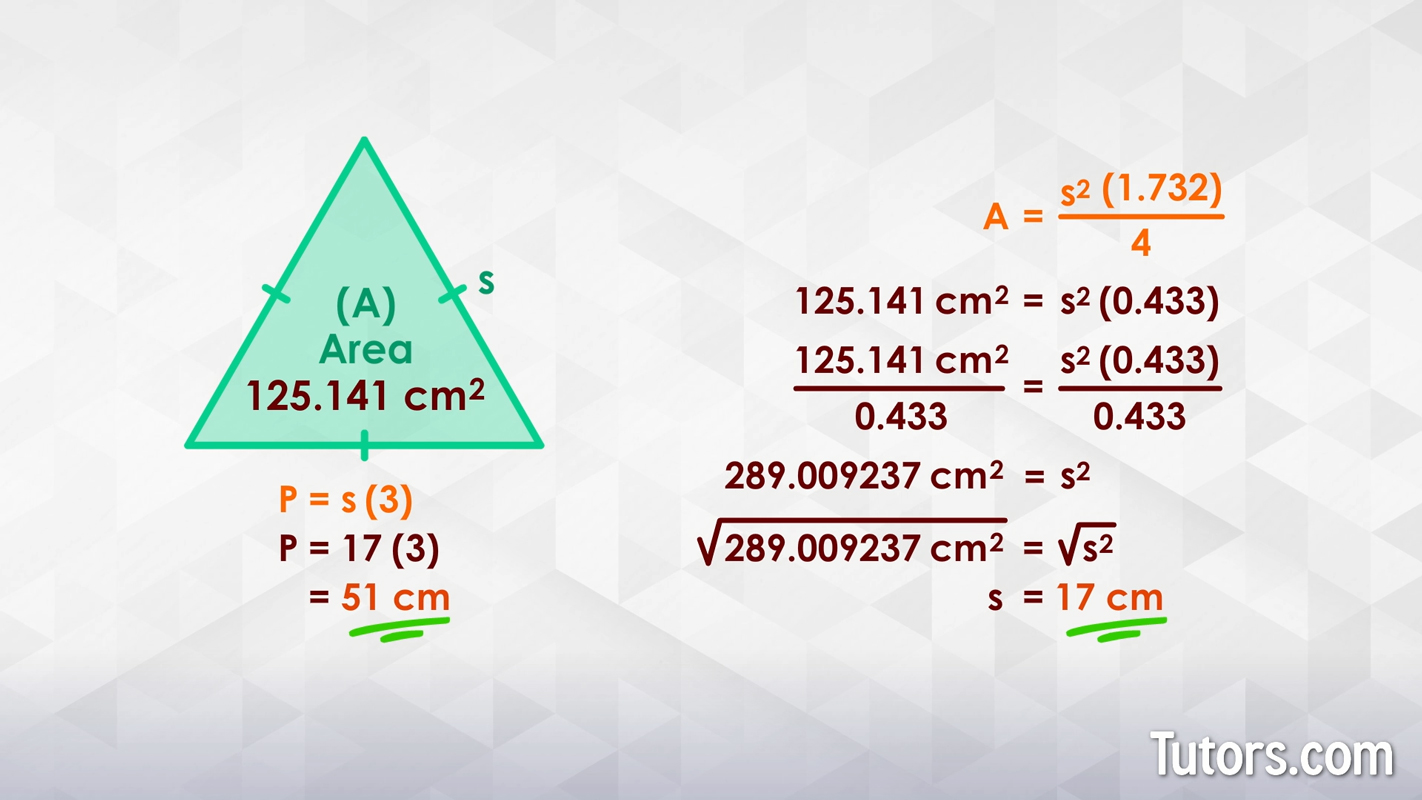How to find perimeter from area
Find perimeter from area
For some geometric shapes, you can find perimeter from the area. With equilateral triangles, squares, and circles, you can use formulas to find their perimeters from their given areas. To find the perimeter of rectangles, you must know the measurement of one side and the area of the rectangle.
How to get perimeter from area
To find the perimeter of a shape using its area begins with the area formula for that particular polygon. This can be done for a few different shapes:

How to find perimeter from area of a triangle
The simplest two-dimensional shape is the triangle, and an equilateral triangle has three congruent sides. You can find the perimeter of an equilateral triangle if you know its area.
The formula for the area, A, of an equilateral triangle with sides of length s is:
We can substitute 1.732 for √3 to make our calculations easier:
Since we are given a value for A, we can use algebra to find s. Our value for perimeter is always a linear measurement derived from the square units of area.
Suppose we are told our equilateral triangle has an area of . That automatically tells us our perimeter will be measured in cm.

We plug in our known values to find our unknown value:
Then, you plug your side length into the perimeter of a triangle formula. The perimeter formula is:
The answer we get is 51 cm.
This process can be simplified to the formula:
Working from the inside out, begin by finding the quotient of , then multiply that quotient times the given area, A, and, last, find the square root of the product of the quotient times area.
A reasonable answer can be found by substituting 1.732 for √3, yielding a value of 1.519693 to be multiplied times any given area.
Find the perimeter of a square from the area
For all the complexities of finding perimeter from the area for an equilateral triangle, the process is far simpler for squares.

A square is the only regular quadrilateral; its sides are congruent, and its interior angles are congruent. If you are given the area of a square, A, in square units, the perimeter, P, in linear units is 4 times the square root of that number:
For our pictured square, we plug in our area, find its square root, and 4 to get the total perimeter:
How to find perimeter of a rectangle with area
You cannot find the perimeter of a rectangle given only the area of a rectangle. You must also know the length or width of the rectangle to produce the perimeter. The sides of a rectangle are not equal in length, so you must know the length of at least one side.
Recall that a rectangle’s area, A, in square units is width (w) × length (l), and perimeter, P, is 2(w+l), in linear units derived from the area units.
Let’s say we have a large rectangular plot of land. Given one side length and the area, you can find the perimeter by substituting the two known values in the formulas:
We know our land is 20 miles wide and covers an area of 500 square miles, so we plug in what we know:
We now use our found value for length, 25 miles, in our formula for perimeter:
How to find perimeter of a circle with area
A perimeter of a circle is called the circumference of a circle.
To find the circumference, C, (perimeter) of the area of a circle, A, you apply the formula:
Here is a circle with an area of . We can plug in our known area into the formula and work from the inside out.

We start by taking a value for π as 3.14 and multiplying it times our given area:
We next take the square root of that:
We finally multiply that times 2:
Yup, that’s a mighty big circle! But the math is correct. The formula works, and it works every time, with every circle.
Quiz
See how well you can find your way around geometric figures. Solve these questions, then check your work against our answers below.
What is the relationship between area and perimeter of a square?
Please explain how to get the perimeter from the area for a square.
Perimeter is always measured in what type of units: linear, square, or cubic?
Please find the perimeter of this figure, a square:

Please work through each question before checking your answers.
The relationship between area and perimeter of a square is that perimeter is 4 times the square root of the area.
To get the perimeter from the area for a square, multiply the square root of the area times 4.
Perimeter is always measured in linear units, which is derived from the area's square units.
The perimeter of a square with an area of is 180m, because the perimeter, P, is , which gives us 4(45m), which gives us 180m.